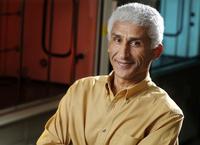Chemistry professor earns recognition in second discipline as newly elected fellow of the American Physical Society

Hedi Mattoussi was recognized several years ago by his peers as one of the world’s top researchers in the field of chemistry and biochemistry. The Florida State University faculty member has now received a similarly prestigious honor from colleagues in a second discipline — that of physics.
Mattoussi, a professor of chemistry and biochemistry in FSU’s College of Arts and Sciences and a faculty member in the university’s Integrative Nanoscience Institute, was just elected a fellow of the American Physical Society’s Class of 2014. The APS is the world’s largest membership organization dedicated to advancing the knowledge of physics. New fellows are chosen by their APS peers for exceptional contributions to the field, such as outstanding physics research, important applications of physics, leadership in or service to physics, or significant contributions to physics education.

Hedi Mattoussi
The APS cited Mattoussi “in recognition of his far-reaching ideas and concepts to interface inorganic nanoparticles with biological systems, which have tremendously impacted on the developments of nanomaterials and biotechnology.”
APS fellows, who are also chosen by their peers, constitute just 0.2 percent of the society’s overall membership; they must demonstrate outstanding and sustained excellence in scientific research.
Mattoussi had previously been elected a fellow of the American Chemical Society (ACS) in 2011.
“I am particularly touched by this nomination, because I started my career as a physicist before progressively morphing into a chemist,” Mattoussi said. “So this nomination, along with the ACS one three years ago, indicates that I am doing a decent job wearing both the physicist and chemist hats.”
Mattoussi’s decades of work in the laboratory have contributed important knowledge that could one day lead to earlier detection of diseases such as cancer or genetic disorders. For more than two decades, he has conducted research in several areas, ranging from the physics of polymers and liquid crystals to the physical chemistry of inorganic nanocrystals (namely luminescent quantum dots, as well as metallic and magnetic nanoparticles) and their interconnections with biological systems.
“Quantum dots and fluorescent metal clusters are very small nanocrystals that glow brightly when you illuminate them,” Mattoussi said. “They are very interesting scientifically due to some unique photophysical features. They are actively investigated by physicists, chemists and engineers for solar cells, light-emitting devices, sensor design, and imaging of biological samples. They could one day provide early detection of diseases such as cancer.”
Timothy Logan, chairman of Florida State’s Department of Chemistry and Biochemistry, described Mattoussi as “a leader in the field from the time QDs were discovered. He is well known for the penetrating chemical insights he brings to designing and developing these quantum dots and for the important biological problems that he is attempting to address with them. Furthermore, the training Dr. Mattoussi provides for undergraduate and graduate students through this research greatly improves their job competitiveness.”
In addition to his contributions to the fundamental understanding of QDs, Mattoussi has added to the scientific knowledge of polymeric materials, the surface functionalization of nanoparticles, the sensing of protein interactions and the imaging of live cells.
Mattoussi started his research career at the Université Pierre et Marie Curie, studied at the Collège de France as a graduate student, then did postgraduate work at several institutions in the United States, including the Massachusetts Institute of Technology.
Joseph Schlenoff, Florida State’s Leo Mandelkern Professor of Polymer Science, brought Mattoussi to FSU in 2009 while Schlenoff was chairman of the chemistry department.
“The impact of Professor Mattoussi’s lifetime of work is remarkable,” said Schlenoff, who first met Mattoussi when both were postdoctoral associates at the Polymer Science and Engineering Center, University of Massachusetts Amherst. “He has had more than 170 interdisciplinary scientific reports on his research published in peer-reviewed journals. Most significantly, his publications have generated (as of February 2014) more than 18,000 citations, with over 85 citations per publication. This clearly reflects the tremendous impact that Professor Mattoussi’s work has had on his peers in the field.”
Mattoussi has initiated several exciting local collaborations since moving to FSU in 2009. These include some research ideas pursued with professors Igor Alabugin, Oliver Steinbock and Associate Professor Kenneth Knappenberger of the Department of Chemistry and Biochemistry, and across campus with Associate Professor Hengli Tang and Professor Deborah Fadool of the Department of Biological Science.
Of his career success, Mattoussi acknowledged “the help I have received from the many postdoctoral researchers, colleagues and graduate students with whom I have worked over the years at several institutions, including the Collège de France in Paris, MIT, the Naval Research Laboratory in Washington, D.C., and now at Florida State. These interactions have made my task easier and the scientific life more fun and rewarding.”

